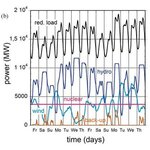Energy

We power humanity mostly by burning fossil fuels, thereby turning chemical energy into heat that ultimately gets radiated into space. In doing so we achieve some results deemed useful: we cook food, we keep our homes and offices at comfortable temperatures, we watch television, listen to music, take hot showers, generate light during dark hours, and move from A to B and back.
Few people have a realistic view on the rate at which mankind turns useful energy into heat, and very few people have realistic expectations on the rate at which the world can transition into a renewable energy…

Today the House Committee on Ways and Means put a likely end to the production tax credit expiration for nuclear energy by approving H.R.5879 - To amend the Internal Revenue Code of 1986 to modify the credit for production from advanced nuclear power facilities. Since new facilities will be public-private partnerships, and public entities can't be taxed, this was creating a lot of confusion and that meant if nothing was done, the incentive for a company to help build an expensive clean energy plant would be gone.
Let's face it, if you didn't get a rebate for a home solar installation…

Using software tools developed by the marketing group Near Zero, which has developed open-source software tools to examine where experts agree and disagree and why, a research group hosted by the Carnegie Institution for Science's Department of Global Ecology has completed the largest expert survey yet of wind energy.
Using that survey platform, the authors gathered responses from 163 of the world's foremost experts on wind energy to forecast future costs for this energy source - as you might expect, they gushed about its future. On average, the wind advocates surveyed predicted wind…
Whatever happened to energy crops? A decade ago, the UK authorities confidently expected farmers to devote swaths of land to growing the likes of short-rotation willow and poplar and perennial grasses. These were to help feed one of the UK’s promising new renewable power sources – biomass energy, which burns plant materials to produce heat and power.
In only a few years, biomass has developed into a major UK power source. It supplies nearly 3GW of the whole electricity supply, getting on for 3% of the total. Locally farmed energy crops were supposed to help reduce the biomass stations'…

A new class of high-performing organic molecules inspired by vitamin B2 can safely store electricity from intermittent energy sources like solar and wind power in large batteries.
The high-capacity flow battery uses organic molecules called quinones, which store energy in plants and animals, and a new class of battery electrolyte material. They contend in their study that it is high-performance, non-flammable, non-toxic, non-corrosive, and its low-cost could enable large-scale, inexpensive electricity storage.
Flow batteries store energy in solutions in external tanks — the bigger the tanks,…

Johns Hopkins Bloomberg School of Public Health graduate student Sara G. Rasmussen, from their Department of Environmental Health Sciences, says that people with asthma who live near bigger or larger numbers of active hydraulic fracturing (fracking) natural gas wells are 1.5 to four times likelier to have asthma attacks than those who live farther away.
The epidemiological correlation published in JAMA Internal Medicine set out to link the fracking industry to health concerns. Other epidemiologists at Bloomberg have done the same, linking fracking to everything from trace chemicals…

A decade ago, ancient technology - using natural water to perform work - was the green goal. Today, dams are bad but now wind is back in fashion.
What changed? Dams got used, and 'our energy production is fine' is a terrible fundraising call to action so current methods have to be criticized. Now, dams that were once prized by activists, they generate more energy than all other renewable sources combined, are being criticized for the devastation of aquatic insect populations and the food webs that those insects underpin. Take that, native American scientists of yore. The virtual…

Solar energy wants to become an alternative source to fossil fuels but no one wants to incur the much higher cost required by continued subsidies. Rather than trying to create large solar farms, which are invariably blocked by environmental lawsuits, the move is on to go small and avoid regulations - that means on buildings, clothes, consumer electronics and wearables. This necessitates ultra-thin film, low-cost and ideally flexible solar cells without compromising the environment during production, use, or disposal.
Most of us know that the most common inorganic solar cells, displayed…

With generous government subsidies and a 'green' halo, wind power is enjoying a lot of financial windfalls. Meanwhile, since being gutted by the Clinton administration in 1993, nuclear energy has been blocked so that it is increasingly less viable.
For that reason, activists thought Sweden would be a good target for their efforts, because they love to tout their lack of emissions. Yet the Swedes would end up with more emissions if they added wind, according to a new paper.
The Swedish power supply is mainly based on a combination of hydroelectric and nuclear power combined with power…

Activists believe that sustained high ($110-120 per barrel) prices will lead to lower carbon emissions because it will make solar and wind seem viable by comparison, but a new study finds that is not true. Why abandon something where the same margin on an expensive product would lead to incredible profit?
Controlling supply leads to people paying thousands of dollars for diamonds, as an example.
But that doesn't mean low prices ($40-55 per barrel) on oil will lead to higher carbon dioxide emissions. If oil prices were to remain low for decades, a country like China, which bullied the…